And beer is why we're here. I don't mean in an existential, why is life on earth sort of way. But two things seemed to have happened five or six thousand years ago that made everything you're looking at right now happen.
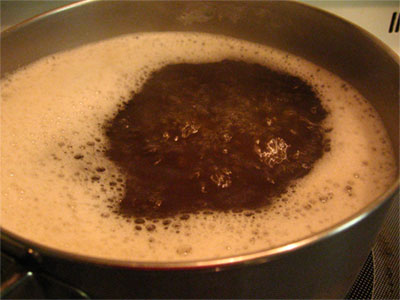
One, was man developed, or was given by God or was anointed by a monolith 2001-style, symbolic thinking. This is what leads to language, stories, the concept of morality, art, politics, music, blogs, and so on.
But more importantly, man went from getting his grog solely from fermented honey and fruit to getting a buzz off beer.
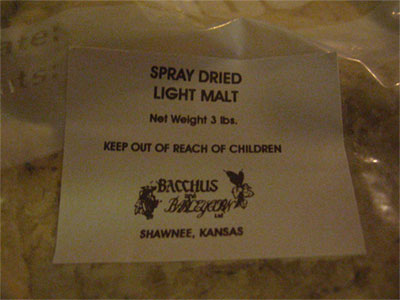
Mead (fermented honey) is probably tied for first with wine and cider for first potable known. Even elephants and birds get tanked on fermenting fruit, so it stands to reason that Neanderthals got a seasonal happy hour in. But collecting honey prior to the Langstroth hive, a 19th Century development, involved destroying the colony of bees. As there got to be more and more people, there was more and more demand for honey, and fewer and fewer bees to do the job.

Faced with the honey equivalent of an oil crisis, Man began relying on cereal grains for fermentables. It's more complicated to make beer: you have to malt the grain (sprout it and then arrest it's growth; mash the malt (allowing enzymes to naturally convert starch to sugar, which happens at temperatures between 149º and 158º F), then ferment the sugars. More work than smashing some apples and letting nature take its course, but you get beer.

And what is better than beer?
Anyways, my little anthropological theory is that reliance on grain meant agriculture, and agriculture is the entry to civilization. So everything from Diet Coke to nuclear bombs basically exists because of beer.
But that's not what I sat down to write about. (Remember Alice? This is a song about Alice...)
No, what I'm posting about is making a starter.
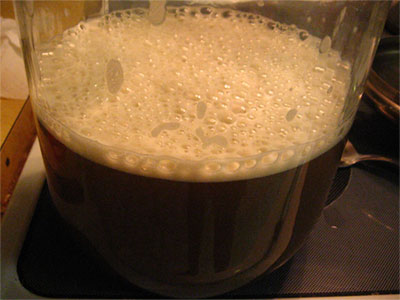
Back when I started homebrewing in 1995, liquid yeast cultures came in relatively small packets. 50ml smack packs in the case of Wyeast; I think White Labs put a slightly larger culture in their vials.
But we all understood that working with liquid cultures (which are far superior in both purity and variety than their dry counterparts) meant making a starter.
Basically a starter is a miniature batch of beer, and it's function is to propagate the yeast into a larger cell count for pitching, and to get it moving, metabolically. Dormant yeast take longer to wake up than yeast that just finished fermenting some wort.
When you rupture the pouch inside the smack pack, you essentially are mixing a starter inside the envelope. The one pint starters I made with 50ml smack packs were good enough for five gallon batches, but of course, I got into ten gallon batches, and sometimes making 20 gallons by making a big beer like an Imperial Stout and making a small beer like a mild off it's second runnings.
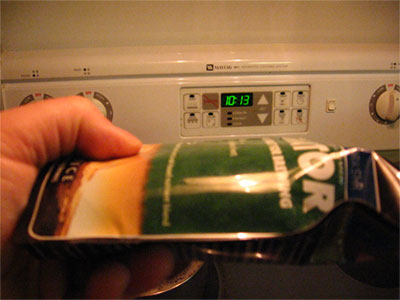
So I learned to ramp those starters up. A pint was the starter for a half gallon. A half gallon could step up to two gallons, which leaves you a half gallon for each five gallon carboy on a 20 gallon brew day.
They were starting to do this when I last brewed, but the yeast makers have really ramped up the size of the packets and they make bold claims about pitchability.
The thing is, a lot of homebrewers want to have the brewing process be a one day affair. Convenience, spontaneity, our on-demand society.
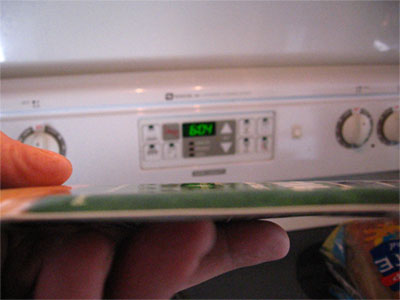
Wyeast even clams its 125ml Activator packets are adequate for five gallons without even letting the packet puff all the way out, and by adequate, they claim it's the pitching rate professional brewers recommend.
I beg to differ. The brewing texts I've read have lead me to conclude that a pint of yeast slurry per five gallons is about what a commercial brewery would pitch. And with lots of beer always in production, this is a quantity of yeast they actually have to scale back from what they could be pitching.
125ml is not a pint. And remember, a pint of slurry, not a pint of wort worked over by a tablespoon of slurry.
So I make starters even when I buy these relatively large cultures. If nothing else, it keeps it from being necessary to pop another $5 for a second pack for the second carboy in a ten gallon batch. Sometime I should A/B it. Make ten gallons, make a starter, and pitch one carboy with the starter and the other with the smack pack contents alone. See which takes off first, and see which beer turns out better.
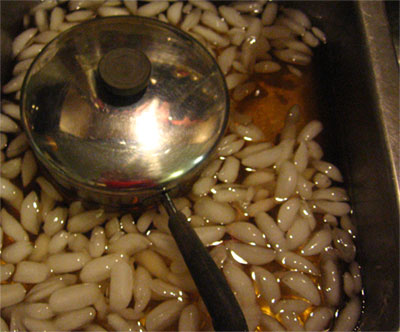
To make a starter (this is a larger starter than you'd use in the old 50ml smack pack days), boil 1 cup of spray dried malt extract in 2 quarts of water for 15 minutes.
Cover the pot, and set it in an icewater bath to chill it. Remember: the bad guys are bacteria and they like it between 80º and 160º F. Get from a boil to 70º-ish as fast as you can.
I use Wyeast's Yeast Nutrient, 1/2 tsp. in this case. Then I hit it with oxygen for 30 seconds, agitate for 20 minutes, oxygen for 30 seconds again and let it do its thing.
The yeast strain I'm using this time is a limited edition of Wyeast's, the Yorkshire strain 1468. They do a set of three yeasts per quarter that aren't otherwise marketed, and now I'm torn on recipe formulation.
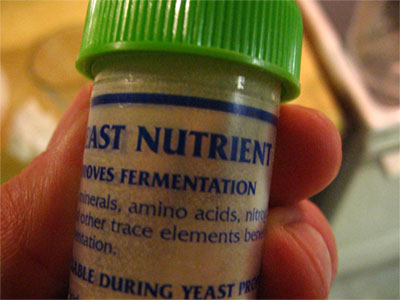
I'd love to make a nice, hoppy IPA. I love IPAs. But another favorite of mine is Old Peculiar, an Old Ale from north Yorkshire, and I have to wonder if this strain isn't the same one Theakston uses for that beer. If so, wouldn't it be nice to have my own interpretation of that classic on tap?
These are the things that occupy a homebrewers mind. Like deciding whether to use a pound of 110º crystal for color and caramel or two pounds of 60º. Whether to use Maris Otter Pale Ale malt or Paul's. Whether to dry hop in the keg...
Which gets to the other reason I make a starter. Even if it's not necessary, it's nice to get a little, miniature brewing experience a couple days before to whet the appetite...

3 comments:
I knew this british guy that used to make his own beer. He stopped eventually because he was too inpatient to wait for it to ferment or whatever it is that it does.
BTW I loved your Bunny Biscuits!
I've never known someone that knew so much about beer...well except for the guys down at the local tavern that drink it from dusk to dawn.
So...Alice? I'm not sure who you were referring to but that's my daughter's name so when I saw that line...it made me realize I better come back here and read some more.
Well, Oopsy, I'm not sure what to make of someone who can't wait for a fermentation to finish because the solution is so obvious: make it faster than you drink it, that way there's always beer on tap, beer conditioning, beer fermenting, and beer you're about to make...
And Networkchik: The Alice line was an Arlo Guthrie reference. In Alice's Restaurant, he gets, I don't know, ten minutes into the story when he comes back to Alice. Then tells the audience that this is not what he came to talk about, that he came to talk about the draft. My mistake is that because I listened to the story until I could recite it when I was 11, I assume everyone is as familiar with it as they are with Green Eggs and Ham.
Post a Comment